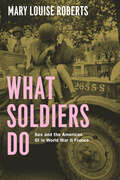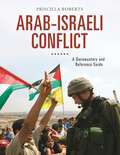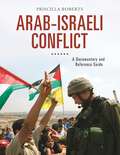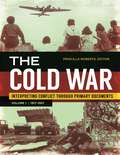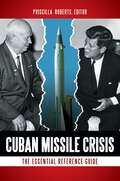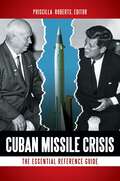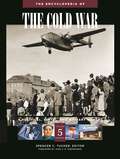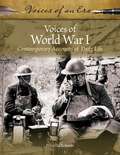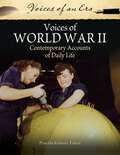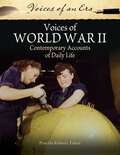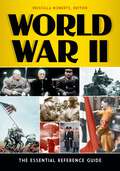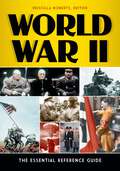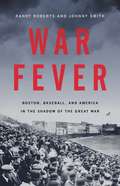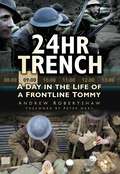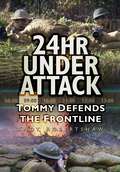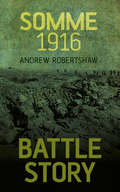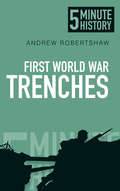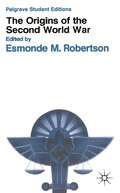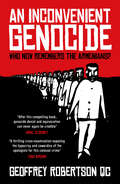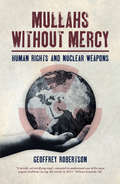- Table View
- List View
What Soldiers Do: Sex and the American GI in World War II France
by Mary Louise RobertsHow do you convince men to charge across heavily mined beaches into deadly machine-gun fire? Do you appeal to their bonds with their fellow soldiers, their patriotism, their desire to end tyranny and mass murder? Certainly—but if you’re the US Army in 1944, you also try another tack: you dangle the lure of beautiful French women, waiting just on the other side of the wire, ready to reward their liberators in oh so many ways. That’s not the picture of the Greatest Generation that we’ve been given, but it’s the one Mary Louise Roberts paints to devastating effect in What Soldiers Do. Drawing on an incredible range of sources, including news reports, propaganda and training materials, official planning documents, wartime diaries, and memoirs, Roberts tells the fascinating and troubling story of how the US military command systematically spread—and then exploited—the myth of French women as sexually experienced and available. The resulting chaos—ranging from flagrant public sex with prostitutes to outright rape and rampant venereal disease—horrified the war-weary and demoralized French population. The sexual predation, and the blithe response of the American military leadership, also caused serious friction between the two nations just as they were attempting to settle questions of long-term control over the liberated territories and the restoration of French sovereignty. While never denying the achievement of D-Day, or the bravery of the soldiers who took part, What Soldiers Do reminds us that history is always more useful—and more interesting—when it is most honest, and when it goes beyond the burnished beauty of nostalgia to grapple with the real lives and real mistakes of the people who lived it.
What Soldiers Do: Sex and the American GI in World War II France
by Mary Louise RobertsHow do you convince men to charge across heavily mined beaches into deadly machine-gun fire? Do you appeal to their bonds with their fellow soldiers, their patriotism, their desire to end tyranny and mass murder? Certainly—but if you’re the US Army in 1944, you also try another tack: you dangle the lure of beautiful French women, waiting just on the other side of the wire, ready to reward their liberators in oh so many ways. That’s not the picture of the Greatest Generation that we’ve been given, but it’s the one Mary Louise Roberts paints to devastating effect in What Soldiers Do. Drawing on an incredible range of sources, including news reports, propaganda and training materials, official planning documents, wartime diaries, and memoirs, Roberts tells the fascinating and troubling story of how the US military command systematically spread—and then exploited—the myth of French women as sexually experienced and available. The resulting chaos—ranging from flagrant public sex with prostitutes to outright rape and rampant venereal disease—horrified the war-weary and demoralized French population. The sexual predation, and the blithe response of the American military leadership, also caused serious friction between the two nations just as they were attempting to settle questions of long-term control over the liberated territories and the restoration of French sovereignty. While never denying the achievement of D-Day, or the bravery of the soldiers who took part, What Soldiers Do reminds us that history is always more useful—and more interesting—when it is most honest, and when it goes beyond the burnished beauty of nostalgia to grapple with the real lives and real mistakes of the people who lived it.
What Soldiers Do: Sex and the American GI in World War II France
by Mary Louise RobertsHow do you convince men to charge across heavily mined beaches into deadly machine-gun fire? Do you appeal to their bonds with their fellow soldiers, their patriotism, their desire to end tyranny and mass murder? Certainly—but if you’re the US Army in 1944, you also try another tack: you dangle the lure of beautiful French women, waiting just on the other side of the wire, ready to reward their liberators in oh so many ways. That’s not the picture of the Greatest Generation that we’ve been given, but it’s the one Mary Louise Roberts paints to devastating effect in What Soldiers Do. Drawing on an incredible range of sources, including news reports, propaganda and training materials, official planning documents, wartime diaries, and memoirs, Roberts tells the fascinating and troubling story of how the US military command systematically spread—and then exploited—the myth of French women as sexually experienced and available. The resulting chaos—ranging from flagrant public sex with prostitutes to outright rape and rampant venereal disease—horrified the war-weary and demoralized French population. The sexual predation, and the blithe response of the American military leadership, also caused serious friction between the two nations just as they were attempting to settle questions of long-term control over the liberated territories and the restoration of French sovereignty. While never denying the achievement of D-Day, or the bravery of the soldiers who took part, What Soldiers Do reminds us that history is always more useful—and more interesting—when it is most honest, and when it goes beyond the burnished beauty of nostalgia to grapple with the real lives and real mistakes of the people who lived it.
What Soldiers Do: Sex and the American GI in World War II France
by Mary Louise RobertsHow do you convince men to charge across heavily mined beaches into deadly machine-gun fire? Do you appeal to their bonds with their fellow soldiers, their patriotism, their desire to end tyranny and mass murder? Certainly—but if you’re the US Army in 1944, you also try another tack: you dangle the lure of beautiful French women, waiting just on the other side of the wire, ready to reward their liberators in oh so many ways. That’s not the picture of the Greatest Generation that we’ve been given, but it’s the one Mary Louise Roberts paints to devastating effect in What Soldiers Do. Drawing on an incredible range of sources, including news reports, propaganda and training materials, official planning documents, wartime diaries, and memoirs, Roberts tells the fascinating and troubling story of how the US military command systematically spread—and then exploited—the myth of French women as sexually experienced and available. The resulting chaos—ranging from flagrant public sex with prostitutes to outright rape and rampant venereal disease—horrified the war-weary and demoralized French population. The sexual predation, and the blithe response of the American military leadership, also caused serious friction between the two nations just as they were attempting to settle questions of long-term control over the liberated territories and the restoration of French sovereignty. While never denying the achievement of D-Day, or the bravery of the soldiers who took part, What Soldiers Do reminds us that history is always more useful—and more interesting—when it is most honest, and when it goes beyond the burnished beauty of nostalgia to grapple with the real lives and real mistakes of the people who lived it.
What Soldiers Do: Sex and the American GI in World War II France
by Mary Louise RobertsHow do you convince men to charge across heavily mined beaches into deadly machine-gun fire? Do you appeal to their bonds with their fellow soldiers, their patriotism, their desire to end tyranny and mass murder? Certainly—but if you’re the US Army in 1944, you also try another tack: you dangle the lure of beautiful French women, waiting just on the other side of the wire, ready to reward their liberators in oh so many ways. That’s not the picture of the Greatest Generation that we’ve been given, but it’s the one Mary Louise Roberts paints to devastating effect in What Soldiers Do. Drawing on an incredible range of sources, including news reports, propaganda and training materials, official planning documents, wartime diaries, and memoirs, Roberts tells the fascinating and troubling story of how the US military command systematically spread—and then exploited—the myth of French women as sexually experienced and available. The resulting chaos—ranging from flagrant public sex with prostitutes to outright rape and rampant venereal disease—horrified the war-weary and demoralized French population. The sexual predation, and the blithe response of the American military leadership, also caused serious friction between the two nations just as they were attempting to settle questions of long-term control over the liberated territories and the restoration of French sovereignty. While never denying the achievement of D-Day, or the bravery of the soldiers who took part, What Soldiers Do reminds us that history is always more useful—and more interesting—when it is most honest, and when it goes beyond the burnished beauty of nostalgia to grapple with the real lives and real mistakes of the people who lived it.
Arab-Israeli Conflict: A Documentary and Reference Guide (Documentary and Reference Guides)
by Priscilla RobertsCovering the Arab-Israeli conflict from its origins to the present, this valuable resource traces the evolution of this ongoing, seemingly unresolvable dispute through a wide array of primary source documents.Arab-Israeli Conflict: A Documentary and Reference Guide provides a fresh, accessible, and thorough overview of the Arab-Israeli conflict, covering its origins in the late-19th century to the present-day situation and enabling readers to grasp why peace has proved so elusive, despite massive international efforts to reach a permanent and lasting solution to this protracted animosity.Chronological chapters first address the years up to the establishment of Israel in 1948, then move forward to the wars of 1956 and 1967 and their impact; the 1973 Yom Kippur War and early efforts to reach a lasting peace settlement; and the ongoing international and Israeli-Palestinian negotiations since the mid-1980s. Readers will come away with not only an understanding of why so many great powers were from the beginning interested in the fate of the territory known as Palestine and of the current issues from an international perspective, but also an appreciation of the personalities and ethnic backgrounds involved that make the conflict so difficult to resolve.
Arab-Israeli Conflict: A Documentary and Reference Guide (Documentary and Reference Guides)
by Priscilla RobertsCovering the Arab-Israeli conflict from its origins to the present, this valuable resource traces the evolution of this ongoing, seemingly unresolvable dispute through a wide array of primary source documents.Arab-Israeli Conflict: A Documentary and Reference Guide provides a fresh, accessible, and thorough overview of the Arab-Israeli conflict, covering its origins in the late-19th century to the present-day situation and enabling readers to grasp why peace has proved so elusive, despite massive international efforts to reach a permanent and lasting solution to this protracted animosity.Chronological chapters first address the years up to the establishment of Israel in 1948, then move forward to the wars of 1956 and 1967 and their impact; the 1973 Yom Kippur War and early efforts to reach a lasting peace settlement; and the ongoing international and Israeli-Palestinian negotiations since the mid-1980s. Readers will come away with not only an understanding of why so many great powers were from the beginning interested in the fate of the territory known as Palestine and of the current issues from an international perspective, but also an appreciation of the personalities and ethnic backgrounds involved that make the conflict so difficult to resolve.
The Cold War [2 volumes] [2 volumes]: 2 volumes [2 volumes]
by Priscilla RobertsThis detailed two-volume set tells the story of the Cold War, the dominant international event of the second half of the 20th century, through a diverse selection of primary source documents.One of the most extensive to date, this set of primary source documents studies the Cold War comprehensively from its beginning, with the emergence of the world's first communist government in Russia in late 1917, to its end, in 1991. All of the key events, including the Berlin Blockade, the Korean War, the Cuban Missile Crisis, the Vietnam War, and the nuclear arms race, are discussed in detail. The primary sources provide insight into the thinking of all participants, drawing on Western, Soviet, Asian, and Latin American perspectives.In The Cold War: Interpreting Conflict through Primary Documents primary documents are organized chronologically, allowing readers to appreciate the ramifications of the Cold War within a clear time frame. Extensive interpretive commentary provides in-depth background and context for each document. This work is an indispensable reference for all readers seeking to become deeply knowledgeable about the Cold War.
Cuban Missile Crisis: The Essential Reference Guide
by Priscilla RobertsDrawing on revealing new research, this richly informative volume is the definitive concise introduction to the crisis that took the world to the brink of nuclear war.Cuban Missile Crisis: The Essential Reference Guide captures the historical context, the minute-by-minute drama, and the profound repercussions of the "Missiles of October" confrontation that brought the very real threat of nuclear attack to the United States' doorstep. Coinciding with the 50th anniversary of the crisis, it takes full advantage of recently opened Soviet archives as well as interviews with key Russian, Cuban, and U.S. officials to explore the event as it played out in Moscow, Havana, Washington, and other locations around the world.Cuban Missile Crisis contains an introductory essay by the author and alphabetically organized reference entries contributed by leading Cold War researchers. The book also includes an exceptionally comprehensive bibliography. Together, these resources give readers everything they need to understand the escalating tensions that led to the crisis as well as the intense diplomacy that resolved it, including new information about the back-channel negotiations between Robert Kennedy and Soviet ambassador Anatoly Dobrynin.
Cuban Missile Crisis: The Essential Reference Guide
by Priscilla RobertsDrawing on revealing new research, this richly informative volume is the definitive concise introduction to the crisis that took the world to the brink of nuclear war.Cuban Missile Crisis: The Essential Reference Guide captures the historical context, the minute-by-minute drama, and the profound repercussions of the "Missiles of October" confrontation that brought the very real threat of nuclear attack to the United States' doorstep. Coinciding with the 50th anniversary of the crisis, it takes full advantage of recently opened Soviet archives as well as interviews with key Russian, Cuban, and U.S. officials to explore the event as it played out in Moscow, Havana, Washington, and other locations around the world.Cuban Missile Crisis contains an introductory essay by the author and alphabetically organized reference entries contributed by leading Cold War researchers. The book also includes an exceptionally comprehensive bibliography. Together, these resources give readers everything they need to understand the escalating tensions that led to the crisis as well as the intense diplomacy that resolved it, including new information about the back-channel negotiations between Robert Kennedy and Soviet ambassador Anatoly Dobrynin.
The Encyclopedia of the Cold War [5 volumes] [5 volumes]: 5 volumes [5 volumes]
by Priscilla RobertsA comprehensive five-volume reference on the defining conflict of the second half of the 20th century, covering all aspects of the Cold War as it influenced events around the world.The conflict that dominated world events for nearly five decades is now captured in a multivolume work of unprecedented magnitude—from a publisher widely acclaimed for its authoritative military and historical references. Under the direction of internationally known military historian Spencer Tucker, ABC-CLIO's The Encyclopedia of the Cold War: A Political, Social, and Military History offers the most current and comprehensive treatment ever published of the ideological conflict that not so long ago enveloped the globe.From the Second World War to the collapse of the Soviet Union, The Encyclopedia of the Cold War provides authoritative information on all military conflicts, battlefield and surveillance technologies, diplomatic initiatives, important individuals and organizations, national histories, economic developments, societal and cultural events, and more. The nearly 1,300 entries, plus topical essays and an extraordinarily rich documents volume, draw heavily on recently opened Russian, Eastern European, and Chinese archives. The work is a definitive cornerstone reference on one of the most important historical topics of our time.
Voices of World War I: Contemporary Accounts of Daily Life (Voices of an Era)
by Priscilla RobertsBringing together a diverse collection of primary source documents, this book illuminates the events and experiences of World War I from a variety of perspectives, from soldiers on the front lines to civilians supporting the war effort at home.Part of Bloomsbury's Voices of an Era series, this carefully curated collection highlight the wartime experiences of a diverse array of individuals from around the globe. In addition to covering major military innovations and turning points, documents explore how issues of gender, race,diplomacy, and empire building impacted individuals' experience of the Great War.Each of the 42 documents includes contextual information and thought-provoking questions to guide readers in their exploration of the text. In addition to high-interest sidebars, in-text glossary definitions, biographical snapshots of key figures, and a comprehensive chronology of the war, the book also includes a guide to evaluating and interpreting primary sources that bolsters readers' analytical and critical thinking skills.Although it was nicknamed "the war to end all wars," World War I heralded the start of modern-day conflicts. The human toll of the Great War was immense-an estimated 9 million soldiers died on the battlefield, while more than 5 million civilians died as the result of military actions, disease, or famine. In the wake of World War I, empires crumbled and new nations won their independence. Although the events and aftermath of World War I happened on an epic scale, the conflict is best understood through the human lens provided by these primary sources.
Voices of World War I: Contemporary Accounts of Daily Life (Voices of an Era)
by Priscilla RobertsBringing together a diverse collection of primary source documents, this book illuminates the events and experiences of World War I from a variety of perspectives, from soldiers on the front lines to civilians supporting the war effort at home.Part of Bloomsbury's Voices of an Era series, this carefully curated collection highlight the wartime experiences of a diverse array of individuals from around the globe. In addition to covering major military innovations and turning points, documents explore how issues of gender, race,diplomacy, and empire building impacted individuals' experience of the Great War.Each of the 42 documents includes contextual information and thought-provoking questions to guide readers in their exploration of the text. In addition to high-interest sidebars, in-text glossary definitions, biographical snapshots of key figures, and a comprehensive chronology of the war, the book also includes a guide to evaluating and interpreting primary sources that bolsters readers' analytical and critical thinking skills.Although it was nicknamed "the war to end all wars," World War I heralded the start of modern-day conflicts. The human toll of the Great War was immense-an estimated 9 million soldiers died on the battlefield, while more than 5 million civilians died as the result of military actions, disease, or famine. In the wake of World War I, empires crumbled and new nations won their independence. Although the events and aftermath of World War I happened on an epic scale, the conflict is best understood through the human lens provided by these primary sources.
Voices of World War II: Contemporary Accounts of Daily Life (Voices of an Era)
by Priscilla RobertsDrawing together a wide variety of primary source documents from across the United States, Europe, and Asia, this book illuminates the events and experiences of World War II—the most devastating war in human history.World War II was the most destructive and disruptive war ever, a global conflict that in one way or another affected the lives of people across the planet. Voices of World War II: Contemporary Accounts of Daily Life coalesces a wide variety of primary source documents drawn from across the United States, Europe, and Asia. Supplemented by interpretive material that enables readers to analyze them, assess their impact and significance, and place them in context to comparable situations today, the documents provide rare insights into World War II. Expert commentaries and additional information on these texts enable a greater understanding of the background to these documents, providing valuable training in learning to interpret, assess, and evaluate historical sources. Intended primarily for upper-level high school and undergraduate-level history students, general readers will also appreciate the variegated array of primary material from World War II, which depicts numerous aspects of the conflict, often in extremely personal terms.
Voices of World War II: Contemporary Accounts of Daily Life (Voices of an Era)
by Priscilla RobertsDrawing together a wide variety of primary source documents from across the United States, Europe, and Asia, this book illuminates the events and experiences of World War II—the most devastating war in human history.World War II was the most destructive and disruptive war ever, a global conflict that in one way or another affected the lives of people across the planet. Voices of World War II: Contemporary Accounts of Daily Life coalesces a wide variety of primary source documents drawn from across the United States, Europe, and Asia. Supplemented by interpretive material that enables readers to analyze them, assess their impact and significance, and place them in context to comparable situations today, the documents provide rare insights into World War II. Expert commentaries and additional information on these texts enable a greater understanding of the background to these documents, providing valuable training in learning to interpret, assess, and evaluate historical sources. Intended primarily for upper-level high school and undergraduate-level history students, general readers will also appreciate the variegated array of primary material from World War II, which depicts numerous aspects of the conflict, often in extremely personal terms.
World War II: The Essential Reference Guide
by Priscilla RobertsIn this book an internationally renowned team of historians provides comprehensive coverage of all major campaigns and theaters of World War II, synthesizing the tremendous breadth and depth of source materials on this global conflict. It includes primary-source documents created by both famous leaders and average citizens.World War II: The Essential Reference Guide provides a comprehensive overview of the major events, campaigns, battles, personalities, and issues of World War II, supplemented by a selection of primary-source documents. Comprising essays written by leading international scholars that introduce non-specialist readers to all the major theaters of the war, this volume covers the entire span—both geographically and chronologically—of this far-reaching conflict.A selection of official and personal documents conveys the emotionally charged tenor of the period and the tremendous psychological impact of the war on those involved in it, both directly and indirectly. The book includes scholarly essays on enduring dilemmas of World War II, such as whether the United States justified in dropping the atomic bomb on Japan, as well as comprehensive essays on the causes, course, and consequences of the war.
World War II: The Essential Reference Guide
by Priscilla RobertsIn this book an internationally renowned team of historians provides comprehensive coverage of all major campaigns and theaters of World War II, synthesizing the tremendous breadth and depth of source materials on this global conflict. It includes primary-source documents created by both famous leaders and average citizens.World War II: The Essential Reference Guide provides a comprehensive overview of the major events, campaigns, battles, personalities, and issues of World War II, supplemented by a selection of primary-source documents. Comprising essays written by leading international scholars that introduce non-specialist readers to all the major theaters of the war, this volume covers the entire span—both geographically and chronologically—of this far-reaching conflict.A selection of official and personal documents conveys the emotionally charged tenor of the period and the tremendous psychological impact of the war on those involved in it, both directly and indirectly. The book includes scholarly essays on enduring dilemmas of World War II, such as whether the United States justified in dropping the atomic bomb on Japan, as well as comprehensive essays on the causes, course, and consequences of the war.
War Fever: Boston, Baseball, and America in the Shadow of the Great War
by Randy Roberts Johnny SmithA "richly detailed" portrait of the three men whose lives were forever changed by WWI-era Boston (Michael S. Neiberg): baseball star Babe Ruth, symphony conductor Karl Muck, and Harvard Law student Charles Whittlesey.In the fall of 1918, a fever gripped Boston. The streets emptied as paranoia about the deadly Spanish flu spread. Newspapermen and vigilante investigators aggressively sought to discredit anyone who looked or sounded German. And as the war raged on, the enemy seemed to be lurking everywhere: prowling in submarines off the coast of Cape Cod, arriving on passenger ships in the harbor, or disguised as the radical lecturing workers about the injustice of a sixty-hour workweek.War Fever explores this delirious moment in American history through the stories of three men: Karl Muck, the German conductor of the Boston Symphony Orchestra, accused of being an enemy spy; Charles Whittlesey, a Harvard law graduate who became an unlikely hero in Europe; and the most famous baseball player of all time, Babe Ruth, poised to revolutionize the game he loved. Together, they offer a gripping narrative of America at war and American culture in upheaval.
24hr Trench: A Day in the Life of a Frontline Tommy
by Andrew RobertshawThe trench was the frontline Tommy’s home. He lived, ate, slept, and sometimes died in this narrow passage amongst the slime of mud and blood on the Western Front. His washbasin was a mess-tin, his cooker – a small fire built into the wall, his entertainment – his friends, his fear – the man living in the trench on the other side of No Man’s Land. Over 6 million men died whilst serving in the trenches – how did they live in them? For the first time, World War I historian Andrew Robertshaw and a group of soldiers, archaeologists and historians use official manuals and diaries to build a real trench system and live in it for 24 hours, recreating the frontline Tommy’s daily existence, answering the questions: How do you build a trench quietly? How clean can you really get in a trench? How easy is it to sleep? How do you keep yourself entertained? How to do you stay alive and kill the enemy? And many more… Hour-by-hour, the Tommy’s day unfolds through stunning colour photographs in this ground-breaking experiment in Great War history.
24hr Under Attack: Tommy Defends the Frontline
by Andrew RobertshawTen million military personnel died during the Great War. Many millions of them experienced horrendous enemy attacks on entrenched positions that stretched across France and Belgium, as well as further afield. This groundbreaking book relives twenty-four hours of an actual Platoon under attack, using a battalion war diary to follow the assault hour by hour. A team of historians and archaeologists reconstructs the fighting, revealing how the British Tommy defended his hard-won positions against heavy fire and enemy attack. Robertshaw presents the Great War in colour, as it was experienced, using stunning images to bring the the full force of these frightening assaults to life. This truly is First World War history at its finest.
Battle Story: Tragedy And Triumph (Battle Story Ser. #10)
by Andrew RobertshawThe Battle of the Somme raged from 1 July to 18 November 1916 and was one of the bloodiest fought in military history. It has come to signify for many the waste and bloodshed of the First World War as hundreds of thousands of men on all sides lost their lives fighting over small gains in land. Yet, this battle was also to mark a turning point in the war and to witness new methods of warfare, such as all-arms integrated attacks, with infantry units and the new Tank Corps fighting alongside each other. In this Battle Story, Andrew Robertshaw seeks to lift the battle out of its controversy and explain what really happened and why. Complete with detailed maps and photographs, as well as fascinating facts and profiles of the leaders, this is the best introduction to this legendary battle.
First World War Trenches: 5 Minute History (5 Minute History Ser.)
by Andrew RobertshawHow much can you really find out about the Trenches of the First World War in five minutes? This handy little history book will surpass all your expectations and leave you well versed on all you wish to know, and maybe even a little bit more… Was it always muddy? Was every minute spent under fire? How did they get around? What food was eaten? And how did they build them anyway? Jam-packed with facts, stats and first-hand accounts of the action, all woven together in an accessible way by an expert in the field, this 5 Minute History is a valuable addition to anyone’s bookshelf, ready to be delved into at a moment’s notice.
The Origins of the Second World War
by E.M. RobertsonThis collection of essays deals with some of the problems posed by the origins of World War II. Was World War II part of a developing world crisis or should it be seen purely in a European context? Before 1960 general historical opinion held that World War I 'broke out', World War II was 'precipitated'. Fritz Fischer's and A.J.P Taylor's challenge to this thesis caused a controversy which made it impossible to isolate the causes of the two World Wars.Whether Hitler was an opportunist or a planner (or both) is discussed in a series of articles, the introduction to which considers the irrational element in Hitler's character and the contradictions in his policy. One author presents Hitler's attitude towards Japan and offers reasons why there was so little collusion between Germany and Japan before the end of 1937. Readers are introduced to the ideas of both American and Japanese writers as to the causes of the 'China Incident' of July 1937 and its influence on European politics.Other topics presented include Mussolini's role as an 'icebreaker' for Hitler; Chamberlain's policy of appeasement; the Rome Agreements of 1935 which caused a rift between Britain and France over Ethiopia; Hitler's attitude towards Japan; Roosevelt's movement of the U.S. Fleet; the defeat of France; the Japanese occupation of Indo-China; and other key issues. A plea for historians of the former belligerents to meet periodically in small groups to discuss research concludes this volume.
An Inconvenient Genocide: Who Now Remembers the Armenians?
by Geoffrey RobertsonThe most controversial question that is still being asked about the First World War - was there an Armenian genocide? - will come to a head on 24 April 2015, when Armenians worldwide will commemorate its centenary and Turkey will deny that it took place, claiming that the deaths of over half of the Armenian race were justified. This has become a vital international issue. Twenty national parliaments in democratic countries have voted to recognise the genocide, but Britain and the USA continue to equivocate for fear of alienating their NATO ally. Geoffrey Robertson QC condemns this hypocrisy, and in An Inconvenient Genocide he proves beyond reasonable doubt that the horrific events in the Ottoman Empire in 1915 constitute the crime against humanity that is today known as genocide. He explains how democracies can deal with genocide denial without infringing free speech, and makes a major contribution to understanding and preventing this worst of all crimes. His renowned powers of advocacy are on full display as he condemns all those - from Sri Lanka to the Sudan, from Old Anatolia to modern Syria and Iraq - who try to justify the mass murder of children and civilians in the name of military necessity or religious fervour.
Mullahs Without Mercy: Human Rights and Nuclear Weapons
by Geoffrey RobertsonIran is just years away from building an atomic bomb. Should it succeed, a weapon of monstrous destructive capability will be in the hands of mullahs who should be put on trial for international crimes: massacring political prisoners, assassinating dissidents at home and abroad, and torturing and killing protestors - as Geoffrey Robertson demonstrates in this groundbreaking study. In Mullahs Without Mercy, Robertson explores the chilling consequences of allowing Iran, North Korea and other countries to develop nuclear weapons. With unquestioned legal authority and learning, and in vivid style, Robertson proposes a radical solution: making the production of nuclear weapons an international crime. Indeed he argues that acquiring nukes is already contrary to an international law of human rights: the bomb is an illegal weapon of terror, and the politicians, prelates and scientists who build it are guilty of crimes against humanity. The development of this doctrine will have profound implications for Britain - and for the world.
